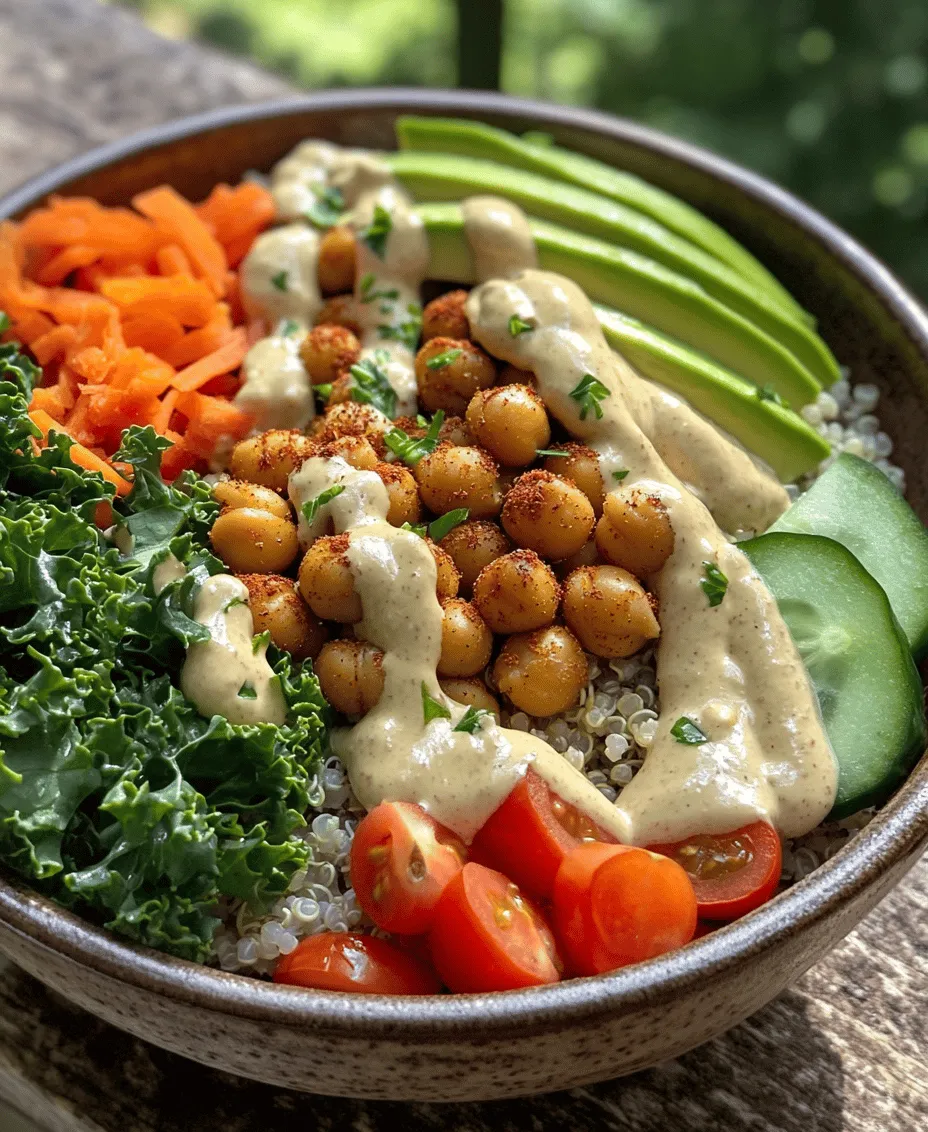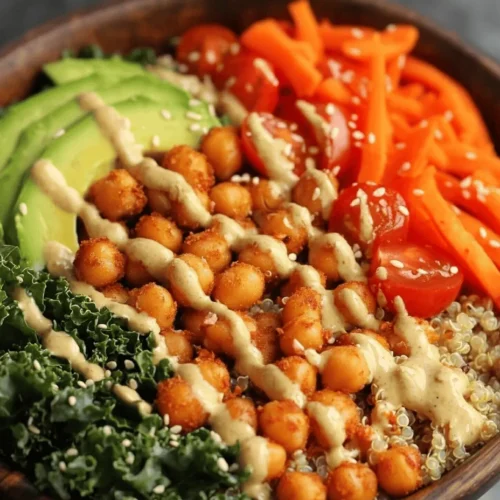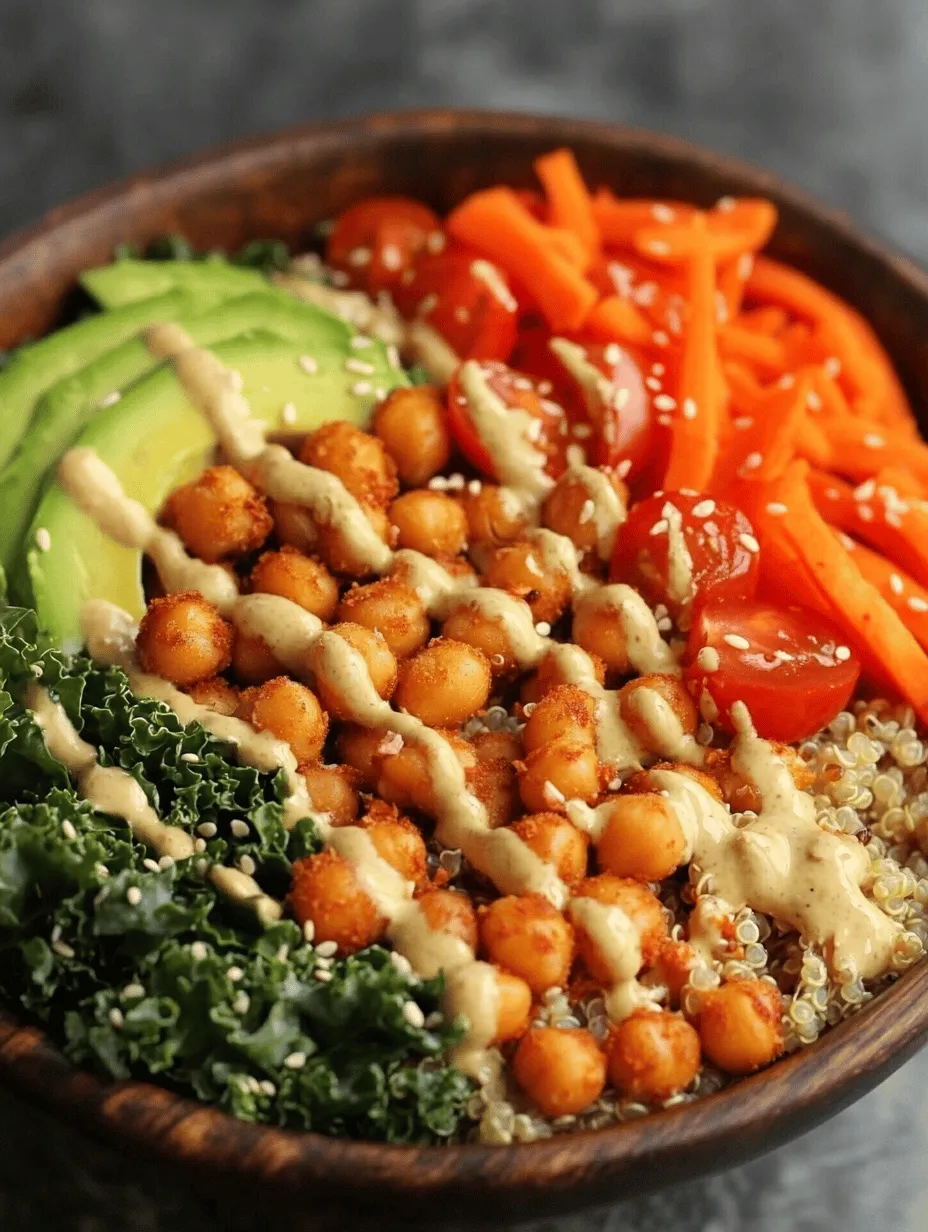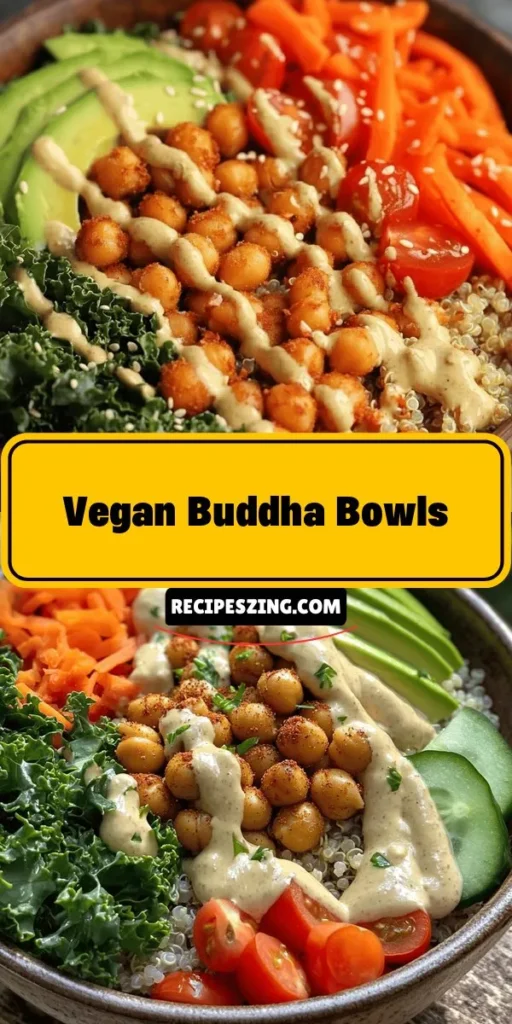Introduction
In recent years, the popularity of plant-based meals has surged, and for good reason. Nourishing Vegan Buddha Bowls not only provide a vibrant array of flavors and textures but also deliver essential nutrients that fuel your body. These bowls have become a staple among health enthusiasts, food bloggers, and home cooks alike, as they offer a versatile canvas for creativity and a balanced approach to nutrition.
When you think of a Buddha bowl, imagine a colorful assortment of ingredients meticulously arranged in a bowl, each component contributing to a harmonious blend of taste and health benefits. This article will explore the beauty and simplicity of creating your own Buddha bowls, highlighting the health benefits of each ingredient, and guiding you step-by-step through the preparation process. Whether you are a seasoned vegan or simply looking to incorporate more plant-based meals into your diet, this recipe will inspire you to create a delicious and wholesome dish.
Understanding Buddha Bowls
Definition and Origin of Buddha Bowls
The term “Buddha bowl” is believed to have originated from the idea of a bowl that is filled to the brim, reminiscent of the rounded belly of a Buddha statue, symbolizing abundance and nourishment. Typically, a Buddha bowl consists of a base of grains, a variety of vegetables, a protein source, and a flavorful dressing, all beautifully arranged to create a visually appealing meal. This style of eating emphasizes balance, showcasing the nutritional benefits of whole foods while allowing for personal expression through ingredient selection.
With roots in various culinary traditions, Buddha bowls draw inspiration from Asian, Middle Eastern, and Mediterranean cuisines. They are not only a feast for the eyes but also a celebration of diverse flavors and textures, making each bowl an exciting culinary adventure.
The Nutritional Value of Buddha Bowls
Nourishing Vegan Buddha Bowls are packed with essential nutrients, making them an excellent choice for anyone looking to boost their health. These bowls typically contain a balance of macronutrients: carbohydrates, proteins, and fats, alongside a rich variety of vitamins and minerals.
– Carbohydrates: Grains like quinoa or brown rice provide a hearty base, offering complex carbohydrates for energy and fiber to aid in digestion.
– Proteins: Chickpeas and other legumes serve as excellent sources of plant-based protein, essential for muscle repair and overall bodily function.
– Fats: Healthy fats, such as those found in avocado and tahini, contribute to satiety and help your body absorb fat-soluble vitamins.
By incorporating a colorful array of vegetables, you not only enhance the flavor profile of your Buddha bowl but also increase its nutritional value. Each vegetable brings its own unique set of vitamins and minerals, contributing to a well-rounded meal.
Why Choose Vegan?
Choosing a vegan lifestyle or incorporating more plant-based meals into your diet has numerous benefits. A vegan diet is often lower in saturated fats and cholesterol, which can lead to improved cardiovascular health. Additionally, plant-based diets are associated with lower risks of chronic diseases, such as diabetes and certain cancers.
Moreover, opting for vegan meals promotes environmental sustainability. Plant-based diets require fewer resources and have a lower carbon footprint compared to diets high in animal products. By creating Nourishing Vegan Buddha Bowls, you are not only nourishing your body but also making a positive impact on the planet.
Key Ingredients for Nourishing Vegan Buddha Bowls
Overview of Essential Ingredients
The beauty of Buddha bowls lies in their versatility. You can mix and match ingredients based on your preferences, seasonal availability, or dietary restrictions. Here are some key ingredients that form the foundation of a delicious Nourishing Vegan Buddha Bowl:
1. Grains: Quinoa, brown rice, farro, or millet serve as the base.
2. Protein: Chickpeas, black beans, lentils, or edamame provide essential amino acids.
3. Leafy Greens: Kale, spinach, or arugula add nutrients and volume.
4. Colorful Vegetables: Carrots, bell peppers, tomatoes, cucumbers, and radishes contribute flavor and crunch.
5. Healthy Fats: Avocado, nuts, seeds, and tahini enhance flavor and texture.
6. Fresh Herbs: Basil, cilantro, or parsley add a burst of freshness.
7. Dressing: A flavorful dressing ties everything together, adding moisture and depth.
Benefits of Quinoa vs. Brown Rice
When selecting a grain for your Buddha bowl, quinoa and brown rice are popular choices. Quinoa is a complete protein, meaning it contains all nine essential amino acids, making it an excellent option for vegans. Additionally, quinoa is gluten-free and packed with fiber, magnesium, and antioxidants.
On the other hand, brown rice is a whole grain that retains its bran and germ, providing more nutrients than white rice. It is rich in B vitamins, manganese, and selenium. Ultimately, both grains are nutritious and can easily be incorporated into your Buddha bowl based on your dietary preferences.
The Power of Chickpeas: Protein and Fiber
One of the standout ingredients in a Nourishing Vegan Buddha Bowl is chickpeas, also known as garbanzo beans. These legumes are an excellent source of protein and fiber, making them a filling and nutritious addition to your meal. Chickpeas are also rich in vitamins and minerals, including iron, magnesium, and folate, contributing to overall health.
In addition to their nutritional benefits, chickpeas are incredibly versatile. They can be roasted for added crunch, blended into dips like hummus, or simply tossed into your bowl for a hearty protein source.
Leafy Greens: Kale vs. Spinach
When it comes to leafy greens, kale and spinach are two popular options for Buddha bowls. Kale is a nutrient-dense superfood, loaded with vitamins A, C, and K, along with antioxidants and anti-inflammatory properties. It adds a robust flavor and a satisfying crunch to your bowl.
Spinach, on the other hand, is milder in taste and packed with nutrients such as iron and calcium. It wilts easily when cooked, making it a great addition to warm Buddha bowls. Both greens offer unique health benefits, and you can choose one or combine them to elevate your dish.
Colorful Vegetables: Carrots, Bell Peppers, Tomatoes, and Cucumbers
The vibrant colors of vegetables not only make your Buddha bowl visually appealing but also indicate a variety of nutrients. Carrots are rich in beta-carotene, which is converted to vitamin A in the body, promoting healthy vision. Bell peppers, available in various colors, are high in vitamin C and antioxidants, supporting the immune system.
Tomatoes add juiciness and flavor, while cucumbers provide a refreshing crunch. These vegetables can be eaten raw, roasted, or lightly steamed, allowing you to experiment with flavors and textures in your Buddha bowl.
The Role of Healthy Fats: Avocado and Tahini
Healthy fats play a crucial role in a Nourishing Vegan Buddha Bowl, and avocado and tahini are two fantastic options. Avocado is not only creamy and delicious but also packed with heart-healthy monounsaturated fats, which can help to lower bad cholesterol levels. It also contains potassium, fiber, and vitamins E and C.
Tahini, a paste made from ground sesame seeds, is another excellent source of healthy fats. It is rich in calcium, magnesium, and B vitamins. Incorporating tahini into your dressing adds a nutty flavor and creamy texture that elevates your Buddha bowl.
The Importance of Fresh Herbs and Optional Toppings
Fresh herbs can transform your Buddha bowl from ordinary to extraordinary. Herbs like cilantro, parsley, and basil add vibrant flavor and a burst of freshness. They also provide additional nutrients and antioxidants, enhancing the overall health benefits of your meal.
Optional toppings, such as seeds, nuts, or nutritional yeast, can provide an extra crunch or flavor boost. Pumpkin seeds, sunflower seeds, or sliced almonds are great options to sprinkle on top of your bowl, while nutritional yeast adds a cheesy flavor without dairy.
Step-by-Step Preparation of Vegan Buddha Bowls
Creating a Nourishing Vegan Buddha Bowl is a straightforward process that allows you to customize ingredients based on your preferences. Here’s a detailed guide to preparing your delicious bowl.
Preparing the Grains
Begin by preparing your base grain. Whether you opt for quinoa or brown rice, the cooking process is simple. For quinoa, use a ratio of 1 cup of quinoa to 2 cups of water or vegetable broth. Rinse the quinoa under cold water to remove its natural coating, called saponin, which can give it a bitter taste.
In a saucepan, combine the rinsed quinoa and water or broth, bringing it to a boil. Once boiling, reduce the heat to low, cover, and let it simmer for about 15 minutes or until the liquid is absorbed. Remove from heat and let it sit for 5 minutes before fluffing it with a fork.
For brown rice, the ratio is typically 1 cup of rice to 2.5 cups of water. Rinse the rice under cold water, then combine it with water in a pot. Bring it to a boil, reduce to low heat, cover, and simmer for 40-50 minutes, or until the rice is tender and all water is absorbed. Fluff with a fork once done.
Importance of Rinsing Grains
Rinsing grains before cooking is a crucial step that should not be overlooked. This process removes excess starch and debris, resulting in fluffier and less sticky grains. It also helps to eliminate any impurities and can reduce the presence of anti-nutrients, enhancing the overall nutritional profile of your dish.
Cooking Techniques for Perfect Quinoa and Brown Rice
To achieve the perfect texture with quinoa, ensure that you do not overcook it. The grains should be fluffy and separate, with a slightly nutty flavor. Similarly, brown rice should be cooked until tender but not mushy. The key is to monitor the cooking time and adjust the water ratio as needed.
Roasting the Chickpeas
While your grains are cooking, it’s time to prepare the chickpeas. If using canned chickpeas, drain and rinse them thoroughly. For roasted chickpeas, preheat your oven to 400°F (200°C). Spread the chickpeas on a baking sheet lined with parchment paper, ensuring they are in a single layer. Drizzle with olive oil and season with your choice of spices, such as paprika, garlic powder, or cumin.
Roast the chickpeas for 20-30 minutes, shaking the pan halfway through to ensure even cooking. The goal is to achieve a crispy texture; if they are not crispy after the initial time, continue roasting for an additional 5-10 minutes, keeping a close eye to prevent burning.
Seasoning Tips for Maximum Flavor
Seasoning is essential for enhancing the flavors of your Buddha bowl ingredients. Experiment with various herbs and spices when preparing your grains, chickpeas, and vegetables. For instance, adding garlic powder, onion powder, or smoke paprika to your chickpeas can elevate their taste.
Consider marinating your vegetables in a simple dressing of olive oil, lemon juice, and your favorite herbs before roasting or grilling. This extra step infuses flavor and ensures that every bite is packed with deliciousness.
Achieving the Perfect Crispy Texture
The key to perfectly crispy roasted chickpeas lies in thorough drying and even cooking. After rinsing the chickpeas, make sure they are well-drained and patted dry with a paper towel. The drier they are, the crispier they will become in the oven. Additionally, avoid overcrowding the baking sheet, as this can trap steam and prevent them from getting crispy.
Crafting the Tahini Dressing
No Buddha bowl is complete without a delicious dressing that ties all the ingredients together. A simple tahini dressing can be made by combining tahini, lemon juice, garlic, and a splash of water to achieve your desired consistency. Whisk until smooth, adding more water if necessary to thin it out. Season with salt and pepper to taste.
For an added kick, consider incorporating spices such as cumin or smoked paprika into your dressing. This not only enhances the flavor but also adds depth to your overall dish.
Final Thoughts
As you embark on the journey of creating your Nourishing Vegan Buddha Bowl, remember that the beauty of this dish lies in its versatility and the opportunity for personal expression. By choosing your favorite ingredients and flavors, you can create a meal that is not only satisfying but also nourishing for your body and soul. In the next part of this article, we will delve into the assembly and presentation of your Buddha bowl, ensuring that each component shines.

Balancing Flavors: Tips for Adjusting Consistency and Taste
Achieving the perfect balance of flavors and textures is crucial when preparing nourishing vegan Buddha bowls. Here are some tips to help you adjust the consistency and taste to suit your palate:
1. Season Gradually: Start by adding spices and seasonings in small increments. This allows you to taste as you go, ensuring you don’t overpower the dish. Common seasonings include salt, pepper, garlic powder, and smoked paprika.
2. Acidity Matters: A splash of lemon juice or a drizzle of vinegar can brighten up your bowl and elevate the flavors. Acid helps balance richer ingredients like avocado and tahini, so don’t shy away from adding a bit more if it seems dull.
3. Texture is Key: Consider the textures of your ingredients. If your bowl feels too dry, add more dressing or a splash of vegetable broth. Conversely, if it’s too wet, allow it to sit for a few minutes to absorb some moisture or add more grains.
4. Taste as You Go: Always taste your ingredients before incorporating them into your bowl. This will guide you on how much seasoning or dressing to use and help you adjust flavors before serving.
Assembling Your Buddha Bowl
Now that you’ve prepared your base ingredients, it’s time to assemble your nourishing vegan Buddha bowl. Follow these steps for a harmonious blend of flavors and colors:
1. Start with the Base: Begin with your choice of whole grains like quinoa or brown rice. A generous scoop (about 1 cup) serves as the foundation of your bowl.
2. Add Protein: Next, layer in your protein source. For example, ½ cup of roasted chickpeas or any other protein you’ve selected. This ensures your bowl is filling and satisfying.
3. Incorporate Leafy Greens: Add a handful of fresh leafy greens, such as spinach, kale, or arugula. These not only boost the nutritional profile but also add a vibrant green color.
4. Fresh Vegetables: Mix in a variety of fresh vegetables. Consider bell peppers, cucumbers, shredded carrots, or cherry tomatoes, ensuring a mix of colors and textures.
5. Healthy Fats: Include half an avocado or a sprinkle of seeds/nuts to add healthy fats. This will enhance the creaminess and flavor of your bowl.
6. Drizzle with Dressing: Finish your assembly with a generous drizzle of your favorite dressing or sauce. Tahini dressing, lemon-tahini, or a spicy peanut sauce all work beautifully.
Layering Techniques for Visual Appeal
A Buddha bowl is not just about taste—it’s also about presentation. Here are some layering techniques to create an eye-catching dish:
1. Color Contrast: Use a variety of colorful ingredients. Bright orange carrots, deep green spinach, and red tomatoes not only provide visual appeal but also a range of nutrients.
2. Arrange with Purpose: Instead of mixing everything together, arrange ingredients in sections. This creates a beautiful mosaic effect and allows each component to shine.
3. Garnish: Don’t forget to garnish! A sprinkle of sesame seeds, chopped herbs like parsley or cilantro, or even edible flowers can elevate the look of your bowl.
4. Choose Your Bowl Wisely: Opt for wide, shallow bowls that allow your ingredients to spread out. This not only looks attractive but also makes it easier to eat.
Suggestions for Portion Sizes
When it comes to serving sizes, it’s essential to balance nutrition and satisfaction. Here are some general guidelines:
– Grain Base: Aim for about 1 cup of grains as your base.
– Protein: Approximately ½ cup of cooked chickpeas or your chosen protein is ideal.
– Vegetables: Include 1-2 cups of fresh vegetables to ensure a colorful and nutrient-rich bowl.
– Healthy Fats: A ¼ to ½ avocado or a tablespoon of seeds/nuts is sufficient for healthy fats.
– Dressing: Use about 2 tablespoons of dressing to avoid overwhelming the flavors while ensuring moisture.
Health Benefits of Each Ingredient
Understanding the health benefits of each component of your Buddha bowl can enhance your appreciation for this nourishing meal:
Quinoa and Brown Rice: Whole Grains for Energy
Both quinoa and brown rice are excellent sources of complex carbohydrates, providing sustained energy. Quinoa is also a complete protein, containing all nine essential amino acids, making it an ideal choice for vegans.
Chickpeas: A Plant-Based Protein Powerhouse
Chickpeas are rich in protein and fiber, which can help keep you full and satisfied. They also support digestive health and can help stabilize blood sugar levels.
Leafy Greens: Nutrient Density and Antioxidants
Leafy greens like spinach and kale are low in calories but packed with vitamins A, C, and K, as well as antioxidants that support overall health. They are also rich in iron and calcium, making them a crucial addition to a vegan diet.
Avocado: Healthy Fats for Heart Health
Avocados are loaded with heart-healthy monounsaturated fats and potassium. They help lower bad cholesterol levels and contribute to overall cardiovascular health.
Tahini: Rich in Nutrients and Flavor
Made from ground sesame seeds, tahini is a great source of healthy fats, protein, and minerals like calcium and magnesium. It adds a creamy texture and nutty flavor to your Buddha bowls.
The Role of Fresh Vegetables in a Balanced Diet
Fresh vegetables offer a wealth of vitamins, minerals, and antioxidants. They are essential for a balanced diet, promoting good health and wellbeing. Including a variety of colors ensures you get a range of nutrients.
Customizing Your Buddha Bowl
One of the most exciting aspects of Buddha bowls is their versatility. Here are some ideas for customizing your bowl:
Exploring Different Grain Bases
While quinoa and brown rice are popular, consider experimenting with other grains such as farro, barley, or millet. Each grain has a unique flavor and texture, contributing to the overall experience.
Unique Protein Alternatives for Variability
Beyond chickpeas, you can incorporate tempeh, edamame, lentils, or even tofu. Grilling or roasting these proteins can enhance their flavor and add a delightful texture.
Seasonal Vegetables: Adapting to What’s Fresh
Utilizing seasonal vegetables not only enhances flavor but also supports local agriculture. In spring, consider asparagus and snap peas; in fall, sweet potatoes and Brussels sprouts make excellent choices.
Flavor Variations: Experimenting with Dressings and Toppings
Don’t hesitate to try different dressings or toppings to keep your bowls exciting. From creamy avocado dressings to zesty lime vinaigrettes or spicy sriracha, the possibilities are endless.
Serving Suggestions and Pairings
Nourishing vegan Buddha bowls are perfect for various occasions. Here are some serving suggestions that can enhance your dining experience:
Ideal Occasions for Serving Buddha Bowls
Buddha bowls are great for meal prep, quick lunches, or a light dinner. They also make an excellent centerpiece for potlucks or gatherings, allowing guests to customize their bowls to their liking.
Pairing with Other Vegan Dishes
Consider serving your Buddha bowls alongside a refreshing salad, roasted vegetables, or vegan spring rolls for a complete meal. A side of baked sweet potato fries can add a satisfying crunch.
Beverage Options to Complement Your Meal
To complement your flavorful Buddha bowls, consider serving herbal teas, infused water, or a light vegan-friendly wine. Smoothies can also be a delightful pairing, providing extra nutrients and hydration.
Conclusion
Nourishing Vegan Buddha Bowls are not just a meal; they are a celebration of health, flavor, and creativity. This versatile dish allows for endless customization and experimentation, making it suitable for any dietary preference. By understanding the ingredients and their benefits, you can create a satisfying and nutritious meal that nourishes both body and mind. Embrace the joy of cooking and the beauty of plant-based eating with these vibrant Buddha bowls. Whether you’re preparing a quick lunch for yourself or hosting a dinner for friends, these bowls will impress with their flavor and health benefits. Dive into the world of Buddha bowls and discover how they can transform your approach to meals, turning them into an enjoyable and nourishing experience.



